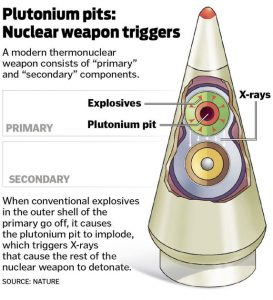
Environmental Impact Statement on Savannah River Site Plutonium Bomb Plant is Inadequate; Dodges Need for New Nuclear Bomb Facility, Overlooks Key Environmental Issues and Claims no Environmental Justice Issues – SRS Watch News Release, September 25, 2020
Columbia, SC – The final Environmental Impact Statement released today by DOE’s National Nuclear Security Administration (NNSA) on the proposed Plutonium Bomb Plant at the Savannah River Site (SRS) – to make plutonium triggers for nuclear warheads – is more of a promotional document than a serious analysis of the need for the facility and its environmental and health impacts, according to the public interest group Savannah River Site Watch.
The EIS, titled Final Environmental Impact Statement for Plutonium Pit Production at the Savannah River Site in South Carolina (SRS Pit Production EIS) (DOE/EIS-0541), was quietly released by NNSA late on September 24 via a news release that apparently wasn’t publicized.
The document contains a cursory review of production of 50 to 125 plutonium “pits” per year in the SRS building previously designed to make plutonium fuel (MOX), a mismanaged project that was terminated in 2018 after a waste of $8 billion. The pits would go to at least two new, controversial warheads – W87-1 and W93 – if Congress allows the warhead projects to go forward, and for about 2500 existing nuclear weapons. This number of weapons is designed to fight a nuclear war and is not a deterrent force, according to SRS Watch. DOE claims that pit production at SRS would start by 2030 but this will likely be impossible, according to SRS Watch.
“The analysis fails to demonstrate that residents of South Carolina and Georgia will be adequately protected from accidents involving plutonium that could be released to air and water by operation of the proposed Plutonium Bomb Plant at SRS,” said Tom Clements, director of SRS Watch. “South Carolina is set to receive around 7.5 metric tons of plutonium to be processed into pits and the EIS totally fails to discuss that and what happens if some of that plutonium ends up being stranded at SRS if the project were to start and then cease operation,” said Clements.
SRS already stores 11.5 metric tons of plutonium, which is slated to be removed through the project charged with that mission – dilution as nuclear waste. But the “dilute & dispose” project is moving very slowly and has not been adequately funded by Congress. Thus, it is likely DOE will want to bring in more plutonium to SRS, for pit production, far in advance of removal of existing plutonium stored in the K-Reactor. “Bringing in more plutonium while SRS still has a stockpile of plutonium is unacceptable and South Carolina citizens must take action to block this unwelcome eventuality,” said Clements.
“The cursory analysis fails to establish the need for the 2500 nuclear weapons that would be outfitted with new pits in order to keep the U.S. on the dangerous footing to fight a full-scale nuclear war,” said Clements. “In particular, the document makes no attempt to justify the new W87-1 and W93 warheads, for which new pits would be first produced if those warhead-development projects were to go forward,” said Clements. “SRS Watch believes that no Record of Decision on the EIS should be issued and that the project should be put on hold while Congress reviews funding and justification for it,” said Clements.
Many problems are clear with the cursory document: the EIS fails to take into account the 100+ year life-time of pits, fails to properly consider reuse of existing pits (15,000 or more are stored at Pantex in TX), brushes off Environmental Justice as being irrelevant, fails to adequately outline how purified plutonium will be produced for pits, reveals no schedule for plutonium import and export and basically admits that 2200 cubic feet or more of low-level waste would likely be dumped annually in SRS trenches.
According to the EIS, up to 1000 cubic yards of plutonium waste (transuranic waste or TRU), 3460 cubic yards of solid low-level nuclear waste (which could be dumped in unlined trenches at SRS) and 1,154,000 gallons of low-level radioactive liquid waste could be generated per year at the SRS Plutonium Bomb Plant. “We are tired of all the existing waste at SRS and unjustified pit production would only exacerbate clean-up challenges,” said Clements.
Link to full news release: SRS Watch news on EIS on PBP Sept 25 2020
News release posted on “Streets of Atlanta” blog site on September 28, 2020: https://streetsofatlanta.blog/2020/09/28/savannah-river-site-is-inadequate-for-a-plutonium-pit-production-facility-and-overlooks-key-environmental-issues/